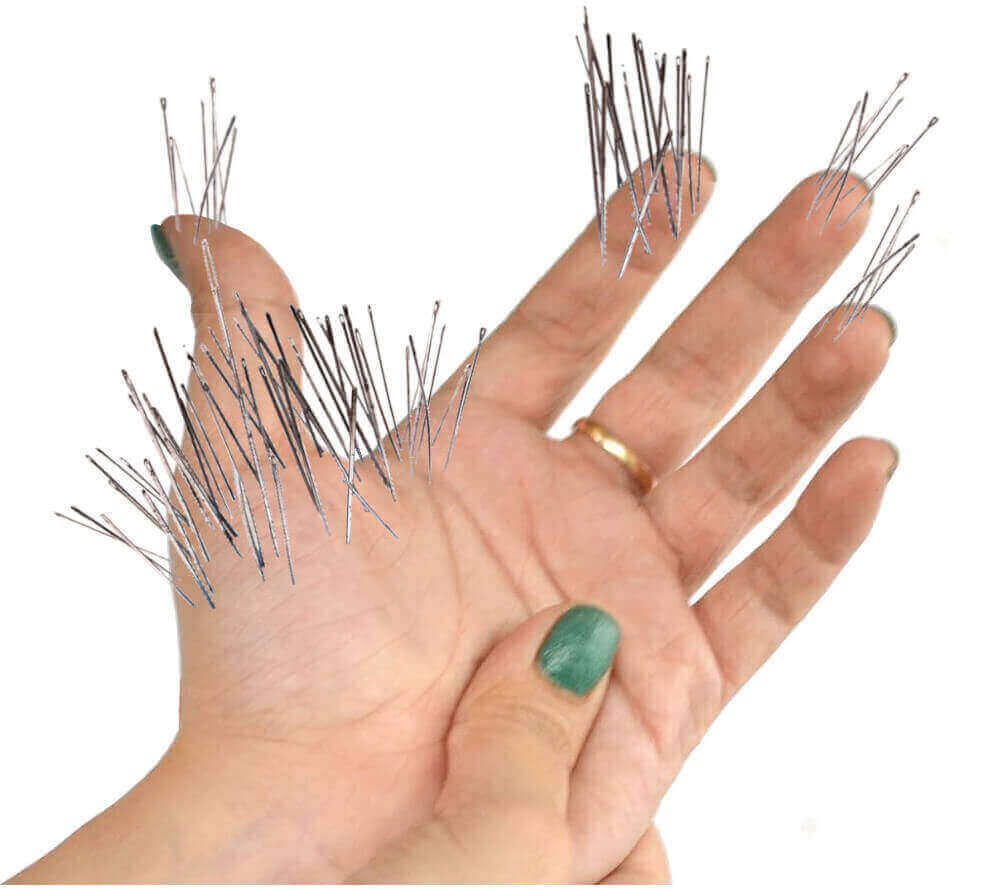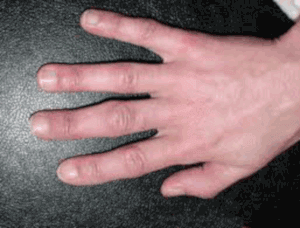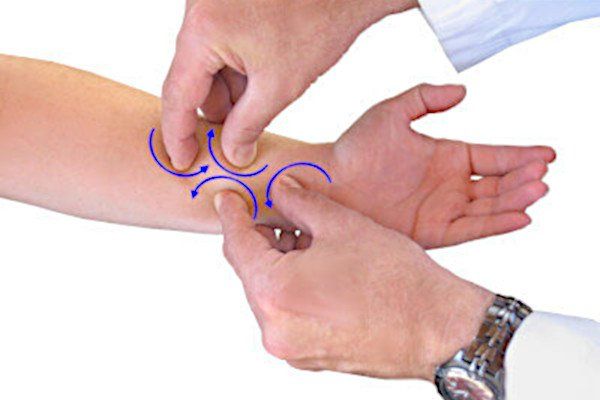Arthritis & Carpal Tunnel Can Be Similar
Table of Contents
- Here's how to tell the difference
- Typical story about getting carpal tunnel
- Typical story about getting arthritis
- Treating carpal tunnel
- Treatment for early stage carpal tunnel syndrome
- Treatment for advanced stage carpal tunnel syndrome
- Treating arthritis
- Short-term strategies
- Long-term strategies
- Summary
It's important to know the difference between arthritis & carpal tunnel syndrome. Since they share similar symptoms, many people wonder which condition they have.
If you believe you have arthritis, carpal tunnel (or another disorder) you should take care of them right away. Many such conditions are treatable, and only worsen if ignored. Catching them
early is your best chance of keeping them under control.
Here's how to tell the difference
The early signs of
carpal tunnel syndrome
usually appear on the
palm of the hand and fingers. But the little finger is never involved. The sensations you feel can be any one (or more) of the following:
In contrast, the
early signs of rheumatoid arthritis (RA) are a little different. These are:
- fatigue
- finger pain
- finger tenderness
- joint stiffness
- swelling in the finger joints and knuckles
Typical story about getting carpal tunnel
Arthritis & carpal tunnel can both attack at any age. Typically they are more common conditions in adulthood.
You can begin to feel
carpal tunnel symptoms in either your dominant or non-dominant hand. Unfortunately, most people don't pay much attention to the
early signs of this disorder. In fact, in the early stages symptoms usually only appear at night, when trying to sleep. This is why hand or finger pain, numbness, tingling (pins-and-needles), and shooting electric shocks (especially in the thumb and middle finger) go untreated for some time.
In most patients, pain or numbness begins to escalate within a few months. Sometimes these symptoms are constant. Other times they are intermittent. Yet in other cases pain can periodically shoot all the way to your elbow. Within 6 months most people can go from the mild stage, through the moderate stage, and into the
severe stage. By then, pain and numbness can be intolerable.
Typical story about getting arthritis
Like carpal tunnel, arthritis symptoms begin slowly. When arthritis attacks the hands, patients typically feel pain in their finger joints. This may feel like a dull ache or a hot, burning sensation. Pain most often appears after you’ve used your hands excessively, for for instance, if you’ve been woodworking, knitting or gardening.
Some people also feel soreness upon waking up in the morning. Others may feel an achiness when it rains or when humidity changes.
Unlike carpal tunnel syndrome, arthritis usually causes joint swelling. The swelling can be very painful and even restrict your finger movement.
Finally, arthritis is usually symmetrical. That means if your right thumb is swollen and painful, you’ll usually have the same symptoms in your left thumb. Rheumatoid arthritis can also be systemic, which means it can also affect your whole body. In that case, symptoms might include shortness of breath, chest pain, fever, and eye inflammation (or dryness).
Treating carpal tunnel
Carpal tunnel syndrome is treatable, especially in its early stages. In fact,
mild or moderate symptoms can often be eliminated in a matter of a few weeks.
Treatment for early stage carpal tunnel syndrome
- Myofascial release massage eliminates adhesions between flexor tendons. this reduces inflammation around the tendons and allows them to glide smoothly.
- Night bracing to allow your wrist to remain in the neutral position (straight). This decompresses the joint's interior, and the
median nerve within that space.
- Stretching exercises for your fingers and hand will help lubricate tendons. Since swollen flexor tendons are the root cause of this disorder, lubrication reduces inflammation and swelling. This in turn decompresses the median nerve.
- Steroid injections are a good way to relieve symptoms. However, such relief is only about 45% effective.
If carpal tunnel symptoms are in the
severe stage, then the above therapies must be performed more regularly. It may also take several more weeks to achieve good relief.
- Open release surgery means the doctor will make a 2-3 inch long incision in your palm. Then the doctor will cut a thick ligament which allows your wrist bones to snap apart. This provides more room for your median nerve so it is not as compressed. This method is
more traumatic than the endoscopic technique.
- Endoscopic release surgery is similar, except the doctor does not require a long incision the palm. Instead, the doctor uses an endoscope to cut the ligament to allow the wrist bones to separate. This operation is less traumatic than the open technique.
Treating arthritis
Rheumatoid arthritis
treatment depends on your age, symptoms, and overall health. It also depends on which type of arthritis you have and how severe it is. In short, a
treatment plan is tailored to the individual person by their doctor.
Arthritis cannot be cured. So the goal of treatment is to limit pain and inflammation, and to make sure you have maximum joint movement. Most treatment plans have both short-term and long-term strategies.
Short-term strategies
- Medicines can afford short-term pain relief by reducing inflammation. Drugs like aspirin, acetaminophen, ibuprofen, and other nonsteroidal anti-inflammatory drugs are helpful.
- Massaging the fingers can relieve pain and promote warmth and blood flow.
- Acupuncture has been shown to be a useful pain reliever for arthritis. It stimulates the release of pain-relieving chemicals in your body.
- New studies recommend certain supplements to significantly reduce the inflammatory effects of RA.
Long-term strategies
- Lifestyle changes can be enormously helpful. This includes healthy eating, reduced weight, regular exercise, yoga, stress management, and rest.
- Surgery is the last option, depending on which joint is affected. Usually only large joints like the knee are candidates. Surgery may include arthroscopy, fusion, or even total joint replacement.
Summary
Arthritis & carpal tunnel syndrome share similar symptoms. But you treat them very differently. Patients who have both conditions may have overlapping symptoms. Therefore, if you treat only one disorder, the symptoms of the other disorder may remain. This is why a diagnosis is crucial: it identifies the disorder(s) so you can treat it (them) effectively.
About







